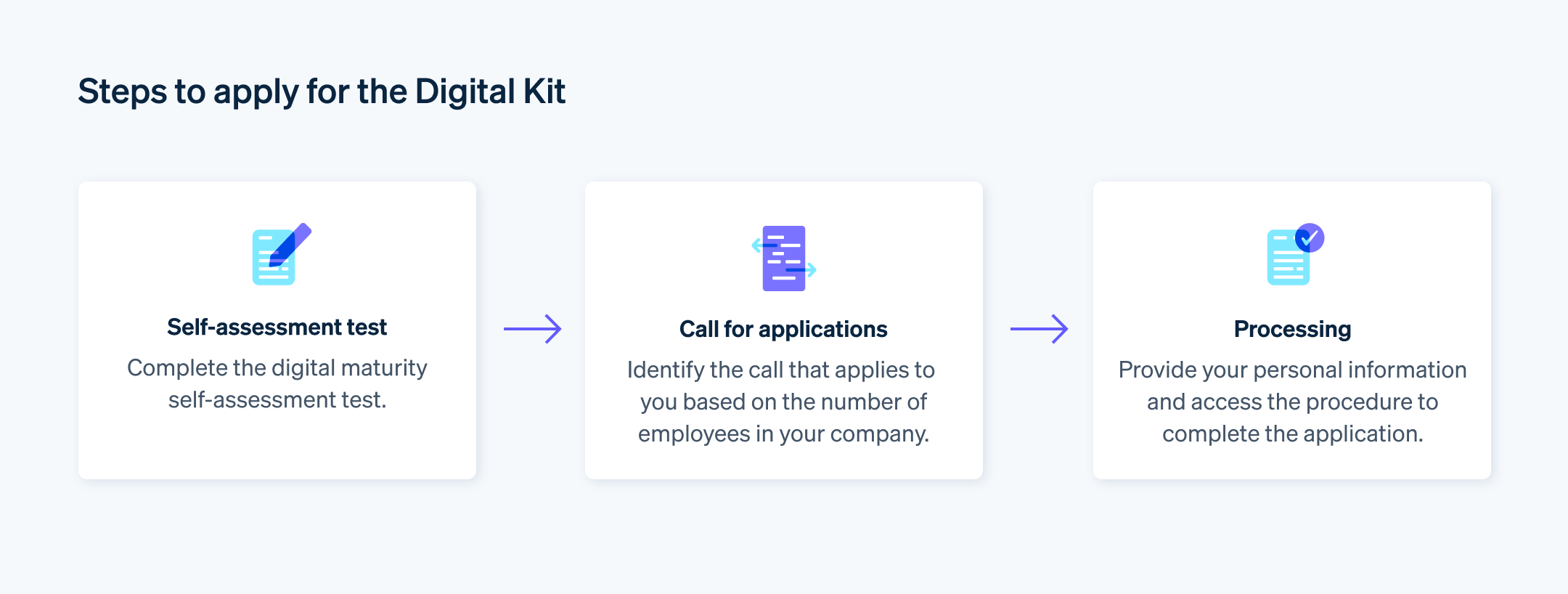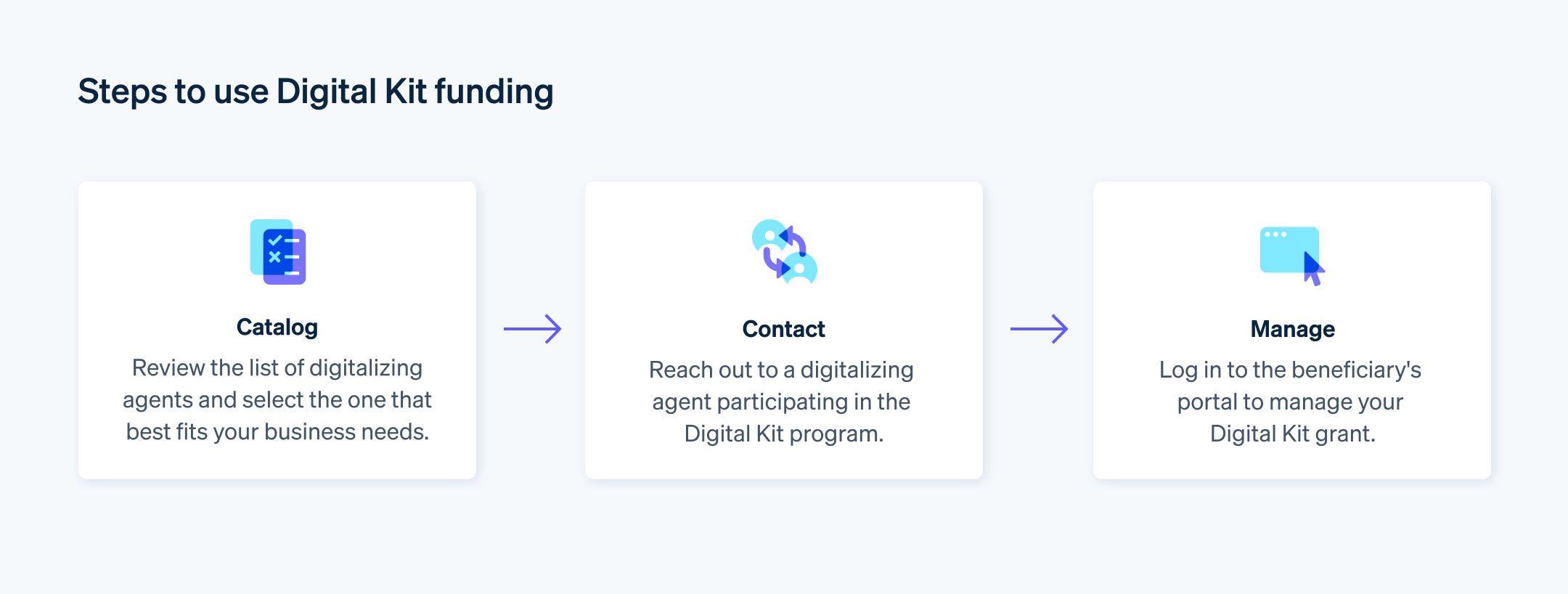Digitalisation in the workplace involves the adoption of digital technologies, such as data analytics and cybersecurity measures, to improve the way a business operates. According to a 2023 report on small and medium-sized enterprise (SME) digitalisation from the National Observatory of Technology and Society (ONTSI), the primary benefits of a company’s digitalisation include reduced workload, cost optimisation, and increased productivity.
To support SMEs, which make up 98.99% of all active companies in Spain, the Ministry of Digital Transformation and Public Service introduced the SME Digitalization Plan in 2021. Additionally, the government of Spain has introduced various initiatives, including Acelera pyme and the Digital Kit, a support programme for digital transformation that we will examine in this article.
What’s in this article?
- What is the Digital Kit?
- How can SMEs and self-employed workers benefit from the Digital Kit?
- How much financial support is available with the Digital Kit?
- Who can apply for the Digital Kit?
- How do I apply for the Digital Kit?
- How can I use the Digital Kit funding?
- How long will the Digital Kit be available?
- Frequently asked questions about the Digital Kit
What is the Digital Kit?
The Digital Kit is a digital transformation programme for SMEs and self-employed workers introduced in November 2021 as part of the Recovery, Transformation, and Resilience Plan. Tasked with implementing the Digital Agenda roadmap, Red.es, a public entity (EPE) under the Ministry for Digital Transformation and Public Service, manages this initiative on behalf of Spain’s government.
The Digital Kit allows SMEs and self-employed workers in Spain to receive a grant for adopting specific technological solutions to advance their business’s digitalisation. The assigned funding for these grants is sourced from the European Union’s (EU) NextGenerationEU programme, which totals €806.9 billion. Official government data shows that, as of 21 September 2024, more than 460,000 SMEs and self-employed individuals received over €1.9 billion in funding from the programme.
The government created the Digital Kit to promote the digital transformation of businesses and enhance the productivity of SMEs in Spain. To achieve this goal, participating companies, known as "digitalising agents," are responsible for implementing technological solutions and developing marketing strategies for SMEs and self-employed individuals utilising the Digital Kit.
How can SMEs and self-employed workers benefit from the Digital Kit?
SMEs and self-employed workers can take advantage of the Digital Kit to:
- Adopt an electronic invoicing system. Businesses can consider implementing systems like TicketBAI or software that complies with the requirements of anti-fraud law.
- Introduce cybersecurity measures. Examples include ecommerce fraud detection and prevention or tools that encrypt two-way communications.
- Create and manage social media profiles. This includes content creation and post impact analytics.
- Sell the SME’s products through a marketplace such as Amazon.
- Create a website.
- Improve the design or functionality of an existing company website.
- Optimise a website’s organic ranking (SEO). The goal of improving a site’s SEO is to appear among the first results shown by search engines (Red.es refers to these initiatives as “advanced internet presence”).
- Create a virtual office. A virtual office can ease communication between employees.
- Leverage business intelligence (BI) and analytics tools.
- Simplify administrative and customer communication tasks. Customer relationship management (CRM) software that supports integration with a payment platform can be helpful. Stripe Payments, for example, easily integrates with websites and CRM systems so a business can start accepting payments within minutes. It also accommodates users’ preferred payment methods, consolidates all revenues in one platform, and contributes to the digitalisation initiative’s aims, such as reducing fraud and costs for SMEs.
How much financial support is available with the Digital Kit?
The amount of Digital Kit funding a business can receive depends on two factors: the type of digital solution the SME or self-employed individual plans to implement and the "segment" the business falls under. The government bases the segments on the business’s number of employees.
This is the maximum Digital Kit funding that businesses could obtain in 2024 depending on the segment:
- Segment I: Small businesses with 10 to 49 employees - €12,000
- Segment II: Small or microbusinesses from 3 to 9 employees - €6,000
- Segment III: Small or microbusinesses with 0 to 2 employees - €3,000
- Segment IV: Medium-sized businesses with 50 to 99 employees - €25,000
- Segment V: Medium-sized businesses from 100 to 249 employees - €29,000
Note that some technological tools are available only to specific segments. For instance, the Digital Kit allows subsidizing for website improvement or search engine optimisation exclusively for companies in segments I, II, and III. You can review these restrictions and the maximum funding amounts on the Acelera Pyme website.
Who can apply for the Digital Kit?
The Digital Kit is open to applications from self-employed individuals and three types of SMEs: micro, small, and medium-sized businesses, regardless of their industry. To qualify for funding, a business must:
- Not exceed the income limits of the segment. These limits correspond to business size based on the number of employees.
- Segment I: Maximum €10,000,000 in revenue
- Segments II and III: Maximum €2,000,000 in revenue
- Segments IV and V: Maximum €50,000,000 in revenue
- Segment I: Maximum €10,000,000 in revenue
If the number of employees places a business in a specific segment but its income exceeds the maximum limit for that segment, it cannot apply for the Digital Kit for that category. However, the business will qualify for the subsidy corresponding to the segment that matches its income level. For instance, if the company has fewer than 50 employees but generates over €10,000,000 in annual turnover, the EU government would qualify it as a "medium-sized business" based on the income thresholds. Consequently, it would fall under Segment IV, even though the employee count would place it in a lower segment.
Not exceed the financial limit of de minimis support. De minimis support is financial aid given by EU countries to eligible businesses. As outlined in Regulation (EU) 2023/2831, the maximum allowable amount member countries can give to qualifying businesses is €300,000 over three years, an increase from the previous limit of €200,000 before the 2023 update.
Not fit the classification for a business in difficulty. For instance, an SME less than three years old undergoing insolvency proceedings would not qualify.
Have fulfilled all tax obligations. For example, a business must file its quarterly VAT return and not have any social security debts.
Register with the Agencia Tributaria. A business must be registered for the minimum amount of time indicated in each call for applications.
Not be subject to any prohibitions outlined in Law 38/2003. A business can’t have received a legal sanction restricting access to future subsidies, for instance, or fail to repay a previous subsidy within the required time frame.
How do I apply for the Digital Kit?
To apply for the Digital Kit, you must register on the Acelera Pyme website and follow the steps below.

After taking a self-assessment to determine your business’s level of digital maturity (i.e., its ability to adapt to technological trends), you can proceed with your application. You’ll need to apply for funding during the application period that matches your business’s segment.
- Segment I: First call for applications
- Segment II: Second call for applications
- Segment III: Third call for applications
- Segment IV: Fourth call for applications
- Segment V: Fifth call for applications
After selecting the relevant call, click the "Access the procedure" button. To identify yourself using your digital certificate or Cl@ve.
How can I use the Digital Kit funding?
If Red.es approves your application, you will receive a subsidy, which you must use. To do so, follow the steps below.

Using and managing your grant tends to be fairly intuitive. First, you access the list of digitalising agents and select the one you believe can provide the best technological solution for your company. The catalogue is extensive, so take your time to make an informed decision.
Next, contact your digitalising agent directly to decide which products or services you want. Inform them that you have support from the Digital Kit. Finally, log in to the processing portal and navigate to the beneficiary area, where you can perform various actions, including checking the available balance of your funds.
How long will the Digital Kit be available for?
The Digital Kit has been or will be available during the following dates, depending on the specific call for applications:
- First call: 15 March 2022 at 11:00 am to 31 December 2024 at 11:00 am
- Second call: 2 September 2022 at 11:00 am to 31 December 2024 at 11:00 am
- Third call: 14 June 2024 at 11:00 am to 31 October 2025 at 11:00 am
- Fourth call: 12 September 2023 at 11:00 am to 31 October 2025 at 11:00 am
- Fifth call: From 12 December 2024 at 11:00 am to 30 June 2025 at 11:00 am*
Frequently asked questions about the Digital Kit
How much can I spend on a new website with the Digital Kit?
The maximum grant for website creation is €2,000. Although the minimum grant for the Digital Kit is €3,000, you must allocate the remaining €1,000 to another purpose, such as buying a computer.
How much can I spend on social networks with the Digital Kit?
The Digital Kit allows you to spend a maximum of €5,000 on social networks. You can check the limits for each digitalisation feature on the Acelera Pyme website.
What is the maximum Digital Kit grant for self-employed individuals?
The maximum amount of the Digital Kit for self-employed individuals is €3,000, which is the limit set for segment III companies (those with zero to two employees).
How to choose where to allocate Digital Kit funding?
To make an informed decision, it’s important to complete the maturity and cybersecurity assessments. This step is not only mandatory to receive the grant but also helps identify digital gaps in your business, allowing you to address them with the support of the Digital Kit.
If you are within the deadline and meet the requirements outlined above, you can apply for the Digital Kit. If you have any questions, you can consult the Red.es frequently asked questions (FAQs).
The content in this article is for general information and education purposes only and should not be construed as legal or tax advice. Stripe does not warrant or guarantee the accuracy, completeness, adequacy, or currency of the information in the article. You should seek the advice of a competent lawyer or accountant licensed to practise in your jurisdiction for advice on your particular situation.